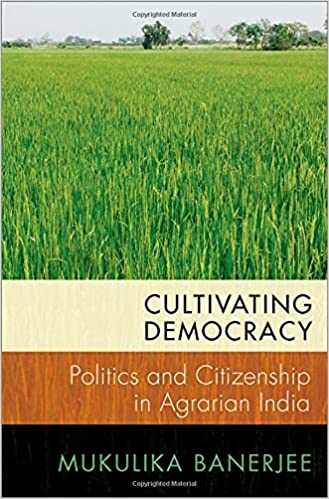
In Cultivating Democracy: Politics and Citizenship in Agrarian India, published by Oxford University Press in 2021, Mukulika Banerjee depicts how the values of republicanism are indispensable for successful democratic practice. This she does through a study of the relationship between formal political democracy and the cultivation of active citizenship in a rural setting in India between the period of 1998 and 2013. The book navigates through the communities and their lifeworld in two villages during elections and the time between them to demonstrate how these two temporalities connect. The sensitive and detailed analysis done by the author portrays how India’s agrarian communities help create practices and ideological space for citizens to be active participants in the country’s democratic exercises.
Chapter 1 of the book introduces the site of this anthropological study, the two villages and describes the associations between agrarian and democratic values in this rural setup. The chapter also discusses the importance of using the approaches of the Manchester School in India and shows how the idea of “the political” comprises both combative and competitive inclinations as well as reparative and cooperative impulsions. The chapter further explains the importance of studying electoral and non-electoral social life together and marks the four key “events” of the book that are elaborated in the consecutive chapters.
In Chapter 2, the author provides a detailed description of the three critical stories of change that form the background of this study – paddy cultivation, electoral politics, and the practice of Islam. Here is depicted the story of the substantial electoral change in the two villages, Madanpur and Chisti, from a time of almost complete dominance of the communist parties of the Left Front from 1977 to their collapse with the unchallenged ascendency of Trinamool Congress in 2013. The chapter further discusses Charles Taylor’s idea of “social imaginaries”, which is a key concept that runs through this book.
Chapter 3 describes the first of the four “events” of the book. The chapter summarises the events of a “scandal” caused by a Comrade’s intervention in a sexual affair between two youngsters in the village. It displays how the process of resolving the scandal urged the people of Madanpur and Chishti to move together through the ideas of friendship, kinship, party loyalty, and marriage to stand against the dreadful machinations of the Comrade’s politics. The second event, a paddy harvest, is presented in Chapter 4. The event captures the dynamics between landowners and workers, members of the agricultural unions and others, and between the Comrade and the rest of the village. The second event also illustrates how prayer meetings in the evenings for the holy month of Ramzan that coincided with the harvest one year led to the public and social expression of the newly forged solidarities.
The ritual of Qurbani, the vital element of one of the two Eids celebrated by Muslims globally, is elaborated in Chapter 5. Other festivals, such as Muharram and Eid-ul-Fitr, are also described in detail to demonstrate how the Islamic community that lived a syncretic life in the two villages have been facing challenges from more recent Islamic movements in South Asia and beyond. This discussion also engages with the concept of ritual to explore the importance of violence and the idea of the sacred and the transcendent in forming values in society.
Chapter 6 presents the final “event” of the book – an election. The analysis moves between the macro level of the region and the micro level of village-based electoral dynamics. In this chapter, the author states that the significant electoral events, such as the end of the power of the Left Front after thirty-four years can be explained only by analysing processes at the local level. Hence, the author focuses on the machinery of election campaigns and the web of campaigners over nine elections. The chapter goes on to analyse public rallies, door-to-door campaigns, and private discussions within families to comprehend the creation of political subjectivity among citizens of India.
Chapter 7 revisits the constitutional challenge over adopting the word “republic” and decodes the term “active citizenship” that forms the core of republican values by calling upon the ideas of Indian and European philosophers. It also looks into constitutional debates and emphasises the limits of visionaries like Ambedkar and Nehru who overlooked the role of village sociality in the architecture of power and governance in independent India. By arguing against dominant ideas and depictions of village life as ignorant and prejudiced, the book contends that the agrarian lifeworld is the model site for the cultivation of civility, vigilance, and accommodation – values that are essential for the creation of democratic culture.
***
Anjana John is a PhD Scholar in the Department of Sociology and Social Anthropology, Central European University.